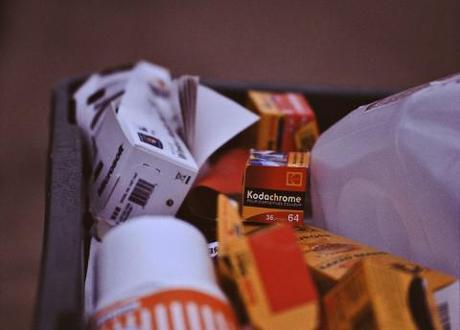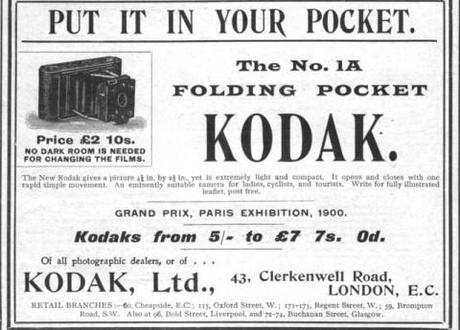
Kodak declared bankruptcy; its famous color film, Kodachrome, was discontinued in 2009. Photo credit: Aging Accozzaglia, http://www.flickr.com/photos/aged_accozzaglia
It’s being called the end of an era: Photography and camera giant Eastman Kodak declared bankruptcy on Thursday after years of decline.
Kodak filed under Chapter 11 of the US bankruptcy code, which protects a company from its creditors while it negotiates with them and seeks to reorganise its business. Its assets are listed as worth $5.1 billion, but its debts as $6.8 billion. The company has won judge approval to borrow $650 million of a $950 million loan from US investment bank Citigroup, to give them 18 months “breathing space” in which to sell 1,100 patents (including the claim on digital imaging rights) – estimated by a Kodak lawyer to worth $2.2 to 2.6 billion.
Kodak was founded by George Eastman 131 years ago, and is known for producing the first mass market camera, the Brownie; in 1900, the Brownie was extravagantly priced at $1. Kodak also created the first digital camera in 1975 – surprising, given that their demise is largely blamed on their reluctance to fully embrace digital technology.
Even Pitbull couldn’t save them. Despite their hugely recognisable branding, and some shameless product placement in rapper Pitbull’s “Give Me Everything”, no one can say they didn’t see this coming. At its peak, Kodak earned $500 million annually for film distribution for motion pictures and 20 years ago brought in revenue at over $16 billion. However, the company has teetered on the brink of collapse for the last decade, with employees falling from 130,000 to 18,800 and losses announced for six of the last seven years.
Death by digital? The Guardian’s Simon Waldman has compared Kodak’s decline to those of the music and newspaper industries, in which successful companies, confident in their supremacy, have been swiftly floored by digital developments. It was a familiar theme: The Independent referenced Nokia’s failure to grasp the potential of the smartphone. According to Robert Burley, professor of photography at Ryerson University in Toronto, “Kodak has been obliterated by the creative destruction of a digital age.”
“Victim of its own success.” Burley has also described Kodak as “unable to make the transition into the 21st century”. Despite producing the first digital camera in 1975, Kodak was concerned that it would eat into their traditional business. They failed to anticipate the pace of technical change, and made the mistake of treating digital imaging as a separate business. The film market, in which Kodak was the world leader, fell by nearly 40 percent between 2008 and 2010. The BBC reported that Don Strickland, the VP who resigned in 1993, left because he failed to get backing to release a digital camera. The decision not to invest in digital meant Kodak was quickly overtaken by Japanese companies such as Canon and Fuji.
“Kodak had its moment. The problem was that it never really worked out what to do when the moment passed. Let that be the lesson,” said Simon Waldman on The Guardian.
End of an era? Despite the confident declaration of “We’re here to save this company” from a Citigroup lawyer, the question of the moment is whether Kodak has any chance of survival. Major entertainment companies owed money by Kodak include Sony ($16.7 million), Warner Brothers ($14.2 million) and Walt Disney Studios ($4.2 million). At this point Kodak can decide whether to reject or continue with these contracts, although a source of IBN Live claims that studios are in discussion with other film suppliers. Kodak’s social media manager tweeted yesterday that customers can expect “business as usual”, but the New York Times’ DealBook argued that this is precisely their problem; Kodak’s turnaround strategy has not been proved and they must file a bankruptcy reorganisation plan by February 2013. The Financial Times suggested that Kodak’s best bet is in the printer division, an intensely competitive market, which executives hope will account for 25 percent of revenue by 2013.

Kodak has indeed been around for awhile. Photo credit: Walwyn, http://www.flickr.com/photos/overton_cat
They don’t care about the old folks. Concern has been expressed that declaring bankruptcy will allow Kodak to shed its retiree obligations in terms of healthcare benefits: ABC News reported Kodak’s responsibility for 25,000 retirees in Rochester, NY alone. Last year the company was forced to promise £536 million to the pension fund over the next decade to make up for the shortfall; the UK scheme had a deficit of £442 million at the end of 2010. The Daily Mail is suitably outraged given that the “financial future of tens of thousands of British pensioners has been thrown into doubt”. Since the British arm of Kodak has not yet filed for bankruptcy, the Pension Protection Fund cannot step in to save the retirement scheme.
A place in everyone’s hearts, if not their wallets. Not only has Kodak been awarded 80 Best Picture Oscars and been used by Neil Armstrong to take close-ups of the lunar surface, it seems to have won a great affection from the public. As Lucy Tobin said in The Independent, “this is a company we care about.” Jasper Rees, writing at The Telegraph, lamented the “end of our Kodak moment”, noting that “we are all Kodak’s executioners”: “As Kodak breathes what appears to be its last, it’s an appropriate moment to wonder whether we have taken a little too much advantage of a revolution that ended its near monopoly. We took fewer, more considered pictures back then, and looked after the results.” The emotional attachment to Kodak has been demonstrated by the surge of”‘send in your own” picture galleries, such as this one on the BBC. Perhaps it’s not just Kodak who didn’t welcome change; The Guardian’s Jonathon Jones wrote, “The precious memory of a Kodak moment has now turned into a permanent frenzy of picture-taking that leaves us with few images of weight or sentiment once the fun is over.”

